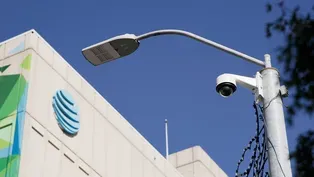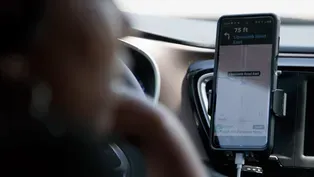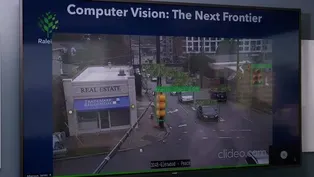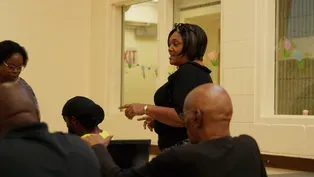
Infrastructure
3/28/2025 | 26m 46sVideo has Closed Captions
Cities embrace technology to transform aging infrastructure and build a more equitable future.
As cities confront aging infrastructure and growing inequities, local governments turn to tech for solutions and reimagine how cities work. Explore how these innovative approaches—on-demand transit in Wilson, digital equity in Forsyth County and AI traffic cameras in Raleigh—could transform urban life and create more equitable communities.
Problems with Closed Captions? Closed Captioning Feedback
Problems with Closed Captions? Closed Captioning Feedback
ncIMPACT is a local public television program presented by PBS NC

Infrastructure
3/28/2025 | 26m 46sVideo has Closed Captions
As cities confront aging infrastructure and growing inequities, local governments turn to tech for solutions and reimagine how cities work. Explore how these innovative approaches—on-demand transit in Wilson, digital equity in Forsyth County and AI traffic cameras in Raleigh—could transform urban life and create more equitable communities.
Problems with Closed Captions? Closed Captioning Feedback
How to Watch ncIMPACT
ncIMPACT is available to stream on pbs.org and the free PBS App, available on iPhone, Apple TV, Android TV, Android smartphones, Amazon Fire TV, Amazon Fire Tablet, Roku, Samsung Smart TV, and Vizio.
Providing Support for PBS.org
Learn Moreabout PBS online sponsorship- [Narrator] "ncIMPACT" is a PBS North Carolina production, an association with the University of North Carolina School of Government.
Funding for "ncIMPACT" is made possible by.
- [Narrator] Changing the course of people's lives.
That's the impact UNC Health and the UNC School of Medicine work to deliver every day.
Our 40,000 team members across the state of North Carolina are committed to caring for you, our patients, and communities, as well as educating the next generation of healthcare professionals.
Individually, we can do a little, but collectively, we can do a lot to create impact.
- From AI to on-demand transit, advances in technology promise to transform our world.
We'll explore how communities are making sure these advances reach everyone.
[upbeat music] Welcome to "ncIMPACT."
I'm Anita Brown-Graham.
Without reliable transportation, job opportunities and doctor visits may remain out of reach for some.
In Wilson, leaders ditch their public buses as transportation infrastructure for an Uber-like service.
We'll find out if this bold experiment has transformed small town transit.
- Small town public transit is kind of like that old vending machine in the break room: everyone knows it's lousy, but it's just kind of always been there.
People complain, but nothing is ever done.
Well, the city of Wilson, North Carolina decided to do something about their public transit system.
They pulled the plug.
This was Wilson's public bus system, six routes covering only 40% of the city, riders waiting up to an hour between buses.
And Wilson isn't alone.
Across rural America, public transit is broken.
Mass transit is built for the masses.
It's right there in the name.
It's not meant to meet individual needs.
So in 2020, Wilson did something radical, and overnight, their city buses went extinct.
They replaced their buses with a fleet of on-demand vans, similar to Uber, but run by the city.
But before we call this a miracle solution, I gotta ask, could this really be the answer to rural transportation woes, or is this just another example of high-tech hype that falls a bit short?
Let's find out.
[upbeat music] Every morning in Wilson, North Carolina starts pretty much the same way, with Kutina Winston checking her first ride of the day.
- We go to Walmart, I'm going to say, maybe 10 times a day.
- Okay.
But Kutina isn't your typical rideshare driver.
She's part of a bold experiment in public transportation.
- I'm actually gonna go to the terminal.
So it'll pop back on where I can get a ride.
- [David] Okay.
While riding along with Kutina, her tablet chirps with a new request.
It's Ms. Pamela, one of her regulars.
- [Kutina] Now, put your hand on my hand.
- [Pamela] Okay.
Always a lot of questions.
- [Kutina] No, you all right.
Back up.
Let me move this out of the way.
- [Pamela] All right.
[Kutina laughs] - [Kutina] All right, love.
Thank you, ma'am.
- [Pamela] Okay.
- [David] For Ms. Pamela, getting to her medical appointments used to mean hours of planning around the old bus schedule.
Now it just takes a tap on an app.
Did you ever ride the bus?
- [Pamela] Yes.
- Yeah?
How was that?
- [Pamela] It was okay.
- [David] The word "okay" kept coming up in conversations about Wilson's old bus system.
It technically worked, but in a town where many residents don't own cars, okay meant sometimes planning your whole day around a single bus ride.
This is what the fixed route bus system in Wilson looked like.
Before the pandemic, it averaged just less than 1,500 rides per week.
In many small towns like Wilson, low population density means fewer bus riders and less funding.
The result?
Long wait times, limited routes, and restricted hours.
But without frequent reliable transit, rural Americans lose access to jobs, education, and even basics like healthcare and groceries.
The solution some communities have come up with is called microtransit.
It's not quite a bus, not quite an Uber, but it's the middle ground.
It uses technology to coordinate rides in smaller vehicles.
And that's exactly what Wilson RIDE does.
The Wilson RIDE app works just like Uber or Lyft.
What do I do next?
- So we got a thing where you can type in, like, where to.
So wherever you wanted to go.
You can put in an address, or sometimes you can even type in, like, just like Google Maps, I wanna go to Target, or I wanna go to Walmart, or whatever.
- [David] Once you enter your destination, the app connects you with the nearest available van.
But unlike rideshare services, you don't have the option of riding alone.
- You might be sharing that trip.
That's what makes it transit, is sometimes you have people on when you get on.
And they may get dropped off first, or you might get dropped off first.
So that's what makes it transit.
The algorithm, the computer program says what's the best routing, who gets dropped off first, where you get picked up, and what it does- - [David] The service is designed to be accessible to everyone.
Those without smartphones can call to book rides.
And there's even a solution for riders who don't have a bank account.
- Some people don't have a debit card, and they're unbanked, so to speak.
And so when they have cash, they can actually go to the customer service building, deposit the cash with our customer service folks, and they can put those credits on their account.
- [David] The technology might be impressive, but the real test of any transit system isn't in its apps, it's in its impact.
So this is what really surprised me.
Ridership on this new system, it's tripled compared to the old mass bus system.
Let that sink in.
Tripled.
- You know, just like Uber, you can, you know, give a star rating for your trip.
And those that choose to do it, I mean, we're running, like, 4.8, 4.9 out of 5 stars.
I don't think there's many government services that actually get that level of response often.
It's not perfect.
Certainly, we have issues from time to time like there is with any service.
But on the whole, this has really expanded access in the community, and it's done what we wanted it to do, which is to connect people to more work opportunities, as well as, you know, especially when it launched during COVID, you know, those essential services.
- [David] But I'm skeptical that blowing up the public transit system will work in every community.
So I went digging and found this report by some NC State researchers who were just as skeptical.
They studied microtransit pilots across North Carolina to understand what makes them work or not work.
[reflective music] Their key finding?
Well, there's no magic formula.
What works in Wilson might not work in Wilmington, where their system has seen slower ridership growth despite serving a larger population.
The report reveals it's not just about population size, it's about understanding your community's unique needs.
Some cities use microtransit to complement existing bus routes.
Others, like Wilson, replace their entire system.
And some communities use it to serve areas where traditional buses aren't practical.
So what do we make of these conflicting outcomes?
While microtransit isn't a one-size-all-fits solution, the research shows there's significant demand for flexible transit options, especially in lower-density areas that may be underserved by public transportation.
- Transit becomes density dependent, especially when you're on fixed route.
I used to work in the city of Charlotte.
Light rail's a great tool for them to use in the city of Charlotte.
It's a horrible tool and way too expensive of a tool for someone like us.
We don't have the density to support that.
So because of that, because we're a lower-density community, this application works really well.
- [David] But while the service is showing promise, there is one big problem: funding.
The money traditionally used for buses can't easily be redirected to RIDE.
That's because state and federal transit policies still favor traditional bus systems over these newer solutions.
Wilson's been patching the gaps with one-time grants, but even those are running out.
And without steady funding, service remains limited, leaving night shift workers and Sunday travelers stranded.
So Wilson city leaders are pushing for a funding overhaul.
They're asking state and federal officials to modernize their policies to support innovative transit solutions like RIDE.
- Hopefully we get to a place where people see the value in what we're able to do and the example here, and that, you know, this becomes a more permanent funding solution down the road.
- [David] But behind the money and all the statistics are individuals striving to make a better life.
- We're busy all day.
And some of us drive maybe 12 hours a day, and we are moving those 12 hours.
Some of the customers has been using us ever since it started.
So they are relying on us, you know, to come pick them up.
- [David] Maybe that reliance is the best indicator that it's serving the needs of those in Wilson, and it may just give a glimpse into what rural transit could be.
For "ncIMPACT," I'm David Hurst.
- While Wilson reimagines rural transit, bigger cities face their own infrastructure challenges.
We'll discover how city leaders in Raleigh are deploying artificial intelligence, and how it's helping predict everything from traffic accidents to flash floods.
- Artificial intelligence is everywhere.
It's in your pocket, in your home, even at the grocery store.
But what if AI stepped out of our devices and into our streets?
What if it could reshape our cities?
Picture a city where traffic glides effortlessly through intersections, where potential accidents are spotted and prevented before they occur, where flood waters are diverted before they cause damage.
Let's find out how these AI-powered smart cities are putting these solutions to the test, and how they're changing our urban landscapes in real time.
I'm David Hurst.
This is "ncIMPACT."
[upbeat music] When Mark Wittenburg arrived in Raleigh a few years ago from Arizona, he wasn't just stepping into a new role as chief information officer, he was stepping into a city in transformation.
With Raleigh being the third fastest growing city in the nation, the pressure to adapt is constant.
- It is really hard to keep up with everything 'cause it is just moving so quickly.
- [David] But improving a rapidly growing city isn't simple.
For Mark, the first challenge was obvious: traffic.
With each new development comes more vehicles, more intersections, and more potential for accidents.
And there's one question that keeps Wittenburg up at night.
How do you prevent accidents that haven't happened yet?
- We know if an accident happens, we know the state of the intersection, but we don't know if there was, like, a vehicle that nearly missed a pedestrian and then what was happening at the intersection at that point in time.
- [Staff Member] This is 2030.
- [David] For Wittenburg and his team of innovators, the answer isn't just about adding more cameras or hiring more staff.
It's about figuring out how a city can serve its citizens in the age of artificial intelligence.
At the forefront of this initiative are AI-powered cameras strategically placed at key intersections throughout the city.
Using artificial intelligence, they can distinguish between cars, trucks, pedestrians, and cyclists.
This helps engineers spot potential dangers before accidents happen.
- By having these cameras, we can set certain parameters and catch areas of concern before they become a problem or a crash pattern, and maybe make changes so that we can be a little bit more proactive rather than reactive.
- [David] They can use this data to not only make intersections safer, but also make them more efficient, saving time for drivers.
- If we make timing changes and we see a 15-second reduction of delay for a mile or two-mile section and X number of signals, if you apply that to 60,000 people, it can have a monumental impact to Raleigh commuters.
- [David] But Jed thinks there's one more benefit, it could be saving taxpayer money.
- If we can improve the efficiency of a traffic signal, the city wouldn't necessarily have to consider doing a road widening or a capital improvement project, which is significantly more impactful to the people that live along it, costs a lot more, could be a bond.
- Takes a whole lot longer too.
- Correct.
- [David] It was during Hurricane Florence when Kelly Daniel, watching the traffic cameras from the emergency operation center, discovered something unexpected: Those same AI-powered cameras helping manage traffic could be the key to predicting and preventing devastating floods before they happen.
While Raleigh's storm gauges were already monitoring flood levels, combining them with AI analysis of camera feeds offered a new level of predictive capability.
- So if you're waiting till the event happens and you don't have the gauges, you don't have the software to let you know in advance to predict this stuff, and a creek starts flooding over a roadway, well, you know as well as I do, it doesn't take but six inches, maybe a foot at most of water to wash a car down the stream, and you got potential loss of life.
- [Reporter] While Walnut Creek floods, which we're giving you a live look at right now, and spills over- - [David] The system's capabilities were tested in August of 2024 when Tropical Storm Debby approached Raleigh.
Local media reported that Rose Lane, a community with a single access road, became a critical point of concern.
- When we found that was potentially going flood, we went into actions of setting up emergency notifications to be sent prior to the event.
- [David] The data allowed officials to take preemptive action, including adjusting water levels at Lake Johnson.
Water from the lake flows into Walnut Creek, which runs directly under Rose Lane.
- And we did get a little bit of flooding on Rose Lane, but nothing that would stop cars from going going through.
So that was a great thing.
So if we hadn't have lowered it, I'm sure it would've got high enough that you couldn't drive cars through that.
- [David] But as Raleigh embraces artificial intelligence to make streets safer and prevent flooding, I'm curious, where do we draw the line between public safety and privacy?
And how do we know what AI is telling us is accurate?
With 200 cameras watching street corners and AI systems tracking movement patterns, these aren't just theoretical questions.
But Wittenburg says his team has built safeguards into the system's very foundation.
- So at the end of the day, we don't know that you drove through the intersection.
What we know is that a car or a truck or a pedestrian or a bicycle went through the intersection.
So all the data is anonymized.
And really, we're just starting to look at it more from a pattern base.
- How many other cities are using AI?
As Raleigh continues to grow, the pressure to expand these AI systems grows with it.
But for Wittenburg and his team, the human element remains at the center of every decision.
- It's kind of like one of those, do you remember solving those math problems?
And at the end of the day, the professor would always say, "Well, make sure you look at the answer.
And does the answer actually make sense?"
And it's the same thing here, is we wanna make sure that if the AI is telling us that we need to make a change at an intersection, does that change really make sense?
- [David] As cities across America grapple with growth and infrastructure challenges, Raleigh's approach offers a glimpse of what's possible when innovation meets public service.
- So I really believe that as people look at the city services, that they've got an expectation that we're going to be leveraging these technologies to make their life better.
- [David] And the next phase is already taking shape.
A digital twin of Raleigh will soon allow city planners and citizens to visualize how new developments could reshape their neighborhoods, all while AI systems continue learning how to make the city safer and more efficient.
For "ncIMPACT," I'm David Hurst.
- Smart technology works well when everyone has access.
However, it's estimated that millions of North Carolinians still lack access to reliable and affordable internet.
We'll explore how an innovative program in Forsyth County is helping residents to cross the digital divide.
- In today's America, millions are still living without reliable internet access.
Lack of internet access is more than just an inconvenience, it's a barrier to health, employment, and economic opportunity.
And this digital divide isn't new, but it's more critical than ever.
But the challenge is complex.
It's a perfect storm of high costs, limited infrastructure, and a widespread lack of digital literacy across demographics.
So in a world where so many of us connect, work, and stream so easily, how is it that millions are still in digital darkness?
And what's being done about it?
I'm David Hurst.
This is "ncIMPACT."
[upbeat music] [grim music] About 15% of North Carolina does not have high-speed internet.
Look at this map.
Notice those red patches?
Those represent areas without reliable internet access.
In fact, 95% of North Carolinians without high-speed internet live in rural areas.
- Urban areas generally have locations where there is internet and wifi access.
But when you think about the rural areas, not only is there not the infrastructure in some pockets, there's also not, you know, businesses and locations where people can use free wifi.
- [David] The reason?
It's written in our landscape.
From our mountain peaks to our coastal plains, North Carolina's diverse geography makes laying fiber infrastructure both challenging and expensive.
For private internet companies, this creates a difficult business reality: spending millions to build infrastructure that might only serve a handful of customers.
The math, they say, simply doesn't work.
- And if you're not connected and you're not able to participate in that, it's a real disadvantage.
It's like a basic service.
It's becoming like water and electricity, you know, for people to connect.
- [David] This made me wonder, if internet is a basic service like water or electricity, why don't local governments just provide it themselves?
Well, because they can't.
In 2011, the North Carolina General Assembly passed what's called the Level Playing Field Bill.
The legislation effectively prevents North Carolina municipalities from creating their own broadband networks.
While a few cities like Wilson were grandfathered in, most communities face complex legal barriers that make municipal broadband nearly impossible.
As a result, many communities remain dependent on private internet providers.
But even in places where broadband is available, some North Carolinians face a different barrier: cost.
Until recently, help came through the Affordable Connectivity Program, offering $30 monthly discounts on internet bills.
More than 23 million American households depended on this assistance.
Here in North Carolina, over 900,000 families.
That's one in five households across our state.
But in May of 2024, that lifeline disappeared.
- So the biggest problem that people are having right now is finding a plan they can afford.
Because that one was like $30 a month, and it made it possible for everybody to have internet.
When that ended, most of the people didn't get internet back because they couldn't afford it.
- [David] Forsyth County sits at the crossroads of this twin challenge.
In its urban core, families struggle with affordability.
In its rural reaches, the issue is access itself.
Every day, this digital divide creates a tale of two communities: one that's connected, and one that's not.
- So much happens on the internet nowadays.
I mean, if you're trying to check your medical appointments or get lab results, if you wanna check in on your child's homework assignments, if you wanna look for and apply for a job, I mean, all these things are happening over the internet.
- [David] The pandemic pulled back the curtain on just how essential internet access has become, and it spurred Forsyth County into action.
The response was Digital Bridges Forsyth.
It's a coalition of nonprofit and public sector leaders determined to tackle this challenge head on.
By partnering with community technology centers, they created a network of internet access points.
And they did it in areas overlooked by commercial providers.
One of those places is the Rupert Bell Neighborhood Center.
- And so what we try to do is encourage them to utilize, you know, sites that have free internet access.
Winston has 25 computer labs where anyone in our community can go utilize those labs, utilize the internet, utilize the computers to do whatever they need to do.
- [David] But they quickly realized that providing internet access and making it affordable is only half the battle.
For people just coming online, you also have to make sure they know how to use it.
Get this: Nearly one in six working-age adults can't navigate the digital world effectively.
Digital literacy isn't just about knowing how to click a mouse or open a browser.
It's about giving people the tools to fully participate in a world that's online, where job applications, healthcare, education, and even basic services now require digital skills.
- So we had a lot of people on assembly lines.
And after some of those business shut down, a lot of those employees had to go searching for jobs.
And one thing is we don't have paper applications anymore.
And that is all digital.
And that was something new to them that would keep them from getting out there to be productive.
- And so creating a resume, a cover letter, they had never done- - Yes, all of those accessories are needed.
- that before.
- And like I say, just to fill out that application alone, it has to be digital.
- [David] So Forsyth County is repurposing under-utilized recreation centers into digital training hubs.
The county wants to train more than 1,000 people in essential digital skills.
The program covers a range of topics from basic computer and internet use to more advanced areas like cybersecurity and job-specific tech skills.
And when students complete their training, they also walk away with their own internet-enabled device, ready to put their skills to work.
- The people that are involved in this have hands-on in a lot of things that are going on in the city.
And it impresses me that they actually looked at this program, embraced it, and funded it.
- [David] But even as success stories emerge from these training hubs, a familiar challenge persists: affordability.
Remember that federal assistance that got cut?
Well, a different kind of opportunity may be taking shape.
The federal government has committed billions of dollars to flow into communities to build infrastructure and expand access.
Our state's share?
About $1.3 billion, with another 1.5 billion expected on the way.
And Forsyth County believes the right game plan helps them access more of those federal dollars.
- You have to have a coordinated strategy.
You know, you've gotta really think it through and have a detailed plan that you're gonna try to execute on.
That's important to develop the support that you need.
'Cause if you're gonna go out and look for funding, you have to explain to them what you're gonna do and how you're gonna do it.
- [David] And there's also promising news on the innovation front.
New wireless options like Starlink are emerging.
While still expensive today, as these services expand, costs should drop, potentially offering a more affordable solution for hard-to-reach areas than traditional fiber cables.
- There's gonna come a day where, you know, wireless capabilities will be to the point where, you know, maybe some of the costs of the infrastructure won't be so prohibitive, and we can really connect in everywhere in some wireless nature.
That's what we hope.
- [David] In the meantime, Forsyth County leaders aren't just standing by for tomorrow's solutions.
They're tackling today's challenges head on, 'cause the stakes couldn't be higher.
- In this day and age, you have to have internet.
If you do not, you will get left behind.
- [David] For "ncIMPACT," I'm David Hurst.
- We've been trying something new this season.
We're focusing more on the experts on the ground.
Thank you to all the local leaders featured in this episode, who so generously allowed us to share the inspirational stories of their collaborative work.
And thank you to our amazing audience for watching and engaging at such high levels.
Let me know what you think about the new format.
I also love hearing about the solutions you know of out there when we do what we do best as North Carolinians: We work together.
Tell us what your community is doing or how we can help you.
Email us at ncIMPACT@unc.edu, or message us on Facebook or LinkedIn.
And be sure to join us every Friday night at 7:30 on PBS North Carolina for new episodes of "ncIMPACT."
[upbeat music] [upbeat music continues] [upbeat music continues] [upbeat music continues] [upbeat music continues] [upbeat music continues] [upbeat music continues] [gentle music] In a state that has been battered by storms, we spotlight the innovators saving lives, fortifying communities, and navigating an increasingly unclear future.
- [Narrator] "ncIMPACT" is a PBS North Carolina production, an association with the University of North Carolina School of Government.
Funding for "ncIMPACT" is made possible by.
- [Narrator] Changing the course of people's lives.
That's the impact UNC Health and the UNC School of Medicine work to deliver every day.
Our 40,000 team members across the state of North Carolina are committed to caring for you, our patients, and communities, as well as educating the next generation of healthcare professionals.
Individually, we can do a little, but collectively, we can do a lot to create impact.
Video has Closed Captions
Cities embrace technology to transform aging infrastructure and build a more equitable future. (20s)
This City Killed Their Bus System. What Happened Next?
Video has Closed Captions
Wilson, NC killed their bus system for ride-sharing transit. The result? Ridership tripled. (7m 27s)
What Happens When Artificial Intelligence Runs a City?
Video has Closed Captions
See how artificial intelligence is revolutionizing Raleigh's streets and infrastructure. (6m 29s)
Why Millions of North Carolinians Still Don't Have Fast Internet
Video has Closed Captions
See why millions of Americans still can't access reliable internet in 2025. (7m 27s)
Providing Support for PBS.org
Learn Moreabout PBS online sponsorshipncIMPACT is a local public television program presented by PBS NC















